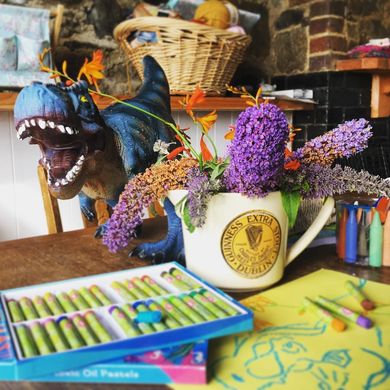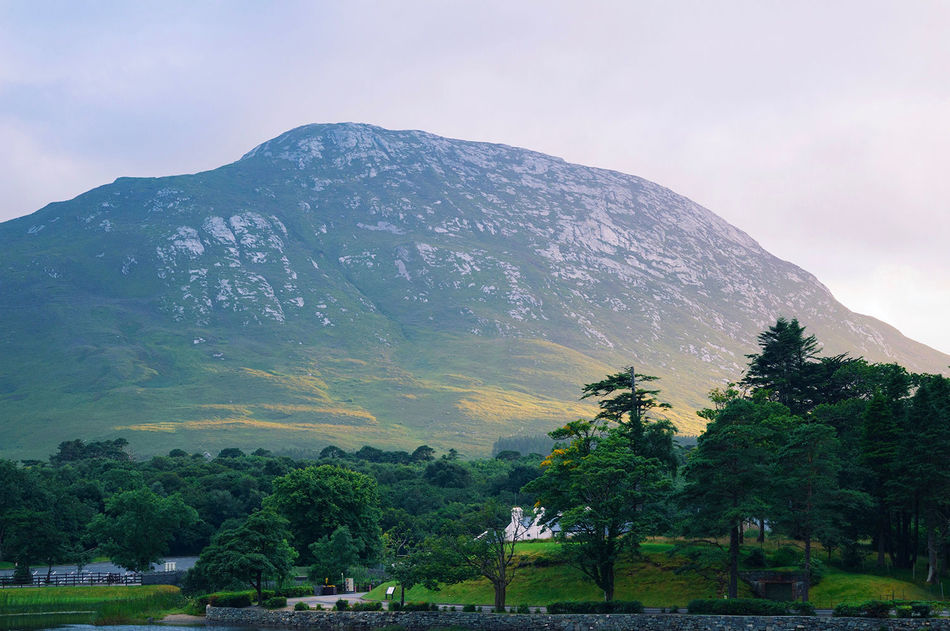Writing in place

Betsy Cornwell lives in the West of Ireland and is a New York Times bestselling author. She holds an M.F.A. in creative writing from Notre Dame and a B.A. from Smith College. Cornwell currently runs the Writing Retreat program at the Kylemore Abbey Global Centre, which is scheduled for August 7-9, 2020.
“I write this sitting in the kitchen sink.”
My favorite novel, Dodie Smith’s 1948 classic I Capture the Castle, begins with place. The first line is charming, immediate, and intimate all at once: as the narrator, seventeen-year-old Cassandra Mortmain, describes her surroundings, she reveals her own personality and state of mind, as well as those of the people around her. The crumbling castle where she lives becomes as much a character in the journal-style narrative as any who move or speak.
I have kept a journal regularly since I was thirteen, and over the years I’ve learned to begin my entries in the same way Cassandra does. When I am not sure what I want to write, I start with where I am, and I describe something that I notice with each of my five senses.
I write this sitting at the dining table in my new home, The Old Knitting Factory in Carraroe. The wildflowers my toddler picked glow purple and orange in their milk jug vase, even as some of them are starting to brown. I can smell them, smell the coffee I made for breakfast and the industrial-strength cleaners I’ve been using in perpetuity since we moved in, trying to clean out this old, unused, beautiful house. I can feel the clear summer sunlight coming through the French doors, and the freshness of the air coming across the lake out back. I can hear the wind that carries that air, and “Precious Memories” by Sister Rosetta Tharpe playing low. I can taste a jaffa cake (I like to snack while I write -- well, I always like to snack).
I am here. I am nowhere else but where I am. It took me so many years to learn how comforting that simple fact can be.

And while I often use my journals as emotional repositories, paper therapists that let me vent and worry my anxious heart out, the writing that I most value years later is the simplest: the sensory details of place and time where I used to be. They let me feel close to my former self, to see my past with fondness and compassion; and then to look on my present that way, too. I’m so glad that nineteen years ago I wrote down the mundane details of where I was the night I had my first kiss; I am so glad that two years ago I wrote down that my baby’s cheeks wobbled like souffle. I know I will be glad, later, for the everyday details I write down now.
In the last few months of lockdown, place-based writing became more of a lifeline for me than ever before. I felt both claustrophobic and overwhelmed as a single working parent. I felt both trapped, and lucky and grateful to be trapped where I was: in a small cottage in Connemara, just a few meters from the sea. I got to know my own house all over again, every room seeming to shrink and grow in a heartbeat rhythm as we waited out our days inside their walls. The nearby shoreline became my toddler’s preschool and the place where I found, over and over again, respite and rescue from my fears about my and my child’s health and future.
That respite, that salvation from anxiety and overthinking and heartache, came when I persuaded myself to let go of the past and future and to notice, sometimes grudgingly, the time and place where I really was. How would my family get through the coronavirus outbreak? I didn’t know, and I was afraid. But I could look out my living room window at the fallow fields and the old stone walls and the thin silver sliver of sea. I could feel the soft spring and give of dough in my hands (like many of us, I baked an awful lot of bread in quarantine). I could listen to the theatrical baritone of my quarantine partner singing as he did the washing-up. I could smell my child’s hair, my favorite scent in the whole world, or the blessed freshness of sea air telling me over and over again how lucky I was to be there, if only I could get present enough to listen.
Writing is how I do that. Writing is one of the best ways into mindfulness that I know. And it is a twofold gift, because it offers that grounding, that sense of place, to both the writer and the reader. Reading is a kind of escapism that is also presence: being fully present in the world created for us. Reading is company when we are isolating, travel while we shelter in place, the chance to be someone else when we can’t stand ourselves any more. And then, somehow, I’ve always found, it leads me back into myself with a little more kindness, a little more room for grace.

I’ve bought and given away at least twenty copies of my favorite book since I first visited the castle when I, like its narrator, was seventeen, and I adore it more every time I come back. I Capture the Castle is a literary home that I return to again and again, just like visiting a favorite vacation spot.
How lucky am I, then, to get to lead a place-based writing retreat in one of my most beloved real vacation spots? Kylemore Abbey, the breathtaking estate nestled into the sweeping mountains of Connemara, is both obviously gorgeous at first look and full of small, secret beauties that keep revealing themselves each time I go back.
As we all venture out of lockdown, I hope you’ll give yourself the gift of retreating with me to this uniquely lovely place, to learn with other writers how to notice the joys of the particular places and times where we find ourselves, and where we find each other. It’s a skill that I am learning over and over again throughout my life, and I know of no other practice more valuable.
Writing and reading, especially about place, have helped me to live the life that I have been given and that I am making. I hope you’ll join me at this retreat as we work on cultivating that gift together. I look forward to being able to say with you:
I write this sitting in Kylemore Abbey.
Learn more about the Writing Workshop with Betsy Cornwell.